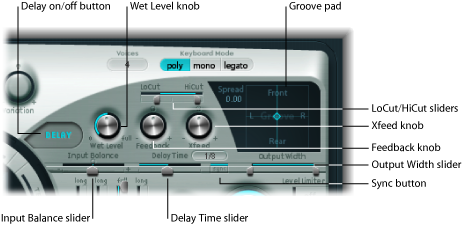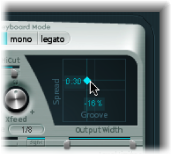Using Sculpture’s Integrated Delay
This is a tempo-syncable stereo delay. It can also run freely (unsynchronized). The Delay section features all the general delay parameters you’d expect from a delay plus the Groove (delay timing) Pad.

- Delay On/Off button: Enables or disables the Delay section.
- Wet Level knob: Sets the level of the Delay output.
- Feedback knob: Defines the amount of delay signal that is routed back from the output channels of the delay unit to the input channels of the delay unit. Negative values result in phase-inverted feedback.
- Xfeed (Crossfeed) knob: Same as the Feedback knob above, but the Xfeed knob defines the amount of delay signal that is fed from the left output channel to the right input channel and the right output channel to the left input channel of the delay unit. Negative values result in phase-inverted feedback of the crossfed signal.
- LoCut slider: Determines the cutoff frequency of the highpass filter at the delay line output/feedback loop.
- HiCut slider: Determines the cutoff frequency of the lowpass filter at the delay line output/feedback loop.
- Groove Pad: Used to graphically adjust delay times. See Using the Sculpture Groove Pad (Stereo).
- Input Balance slider: Moves the stereo center of the Delay input to the left or right, without the loss of any signal components. This makes it ideal for ping-pong delays.
In surround instances, the parameter moves all channels toward the front left or front right channel.
- Delay Time slider and field: Sets the delay time. This can be in either musical note values—1/4, 1/4t (1/4 triplet), and so on (see “Sync button” below)—or in milliseconds.
- Sync button: Sets either tempo-synced or free-running delay modes.
- Output Width slider: Alters the stereo base of the wet signal. A value of 0.0 results in mono output. A value of 1.0 results in full stereo output—the left delay line output channel is panned hard left, and the right delay line output channel is panned hard right, but the stereo center is unaffected.
Note: This parameter is aimed primarily at achieving pure delay grooves in multiple channels, without hard left/right ping-pong panning.
Using the Sculpture Groove Pad (Stereo)
When used in a stereo instance of Sculpture, the Spread and Groove parameters are displayed in the two-dimensional Groove Pad.

- Spread: Useful for wide stereo delay effects. Values on the y-axis (above the default, centered position) increase the delay time of the right delay line or decrease the delay time of the left delay line—in effect, smearing the delay times of the left and right channels. Negative values invert this effect.
- Groove: Distributes the delay taps to the left/right channels, rather than smearing them, like the Spread parameter. Values on the x-axis allow you to reduce the delay time of one delay line by a given percentage, while keeping the other delay line constant. Keep an eye on the small help tag while adjusting.
For example, a value of +50% reduces the right delay time by half. If a value of 1/4 was used as the Delay Time, the right delay would equal 1/8th of a note and the left delay would remain at 1/4 of a note. Needless to say, this parameter is perfect for the creation of interesting rhythmic delays—in stereo.
Drag the diamond in the center of the crosshair to adjust. You can independently adjust the Spread and Groove parameter values by directly dragging the lines that intersect the diamond.
Control-click the Groove Pad to open a shortcut menu that contains Clear, Copy, and Paste commands.
These can be used to copy and paste delay settings between multiple Sculpture instances, or between consecutively loaded settings. The Clear option resets the current delay settings.
Tip: You can create some truly wide chorus and modulated delay effects by modulating the Pickup Position and Pickup Spread parameters with an LFO or other modulator, and then feeding this into the Delay unit.